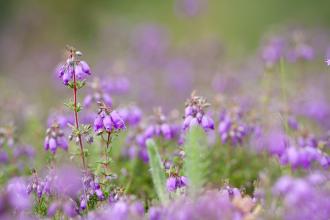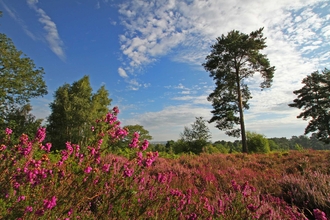The Wealden Heaths National Nature Reserve has been declared by Natural England as the 9th National Nature Reserve (NNR) in the King’s Series, which aims to leave a lasting public legacy for people and nature by creating or extending 25 National Nature Reserves by 2027.
Incorparating 18 existing sites, including three managed by Surrey Wildlife Trust, the new 2,765ha 'Super' NNR sees the expansion of the existing Thursley Common National Nature Reserve, and boasts a rich mix of open dry and wet heath, acidic grassland, regenerating woodland, and scrubby heath.
A collaboration between nine partners, including Surrey Wildlife Trust, Natural England, RSPB, National Trust, and Forestry England, the expanded NNR has secured its status as a haven for wildlife, ensuring that it can provide a home for rare species such as Nightjars, Sand Lizards, Adders and Natterjack Toads into the future and a huge area of beautiful natural greenspace accessible to hundreds of thousands of people.
Surrey Wildlife Trust managed sites incorporated into the new NNR include:
Bagmoor Common
Bagmoor Common is a designated site of special scientific interest (SSSI) and special protection area (SPA), known for its lowland heath and woodland habitats. It is a nationally important site for saproxylic invertebrates such as Stag Beetles. The site also supports breeding Common Toads, dragonflies, and woodland butterflies including the White Admiral and Purple Hairstreak. Part of the Elstead Group of Commons, it is subject to military byelaws.
Rodborough Common
Rodborough Common is a heathland reserve with woodland and acid grassland. It supports reptiles, butterflies such as the Silver-studded Blue, and nationally scarce invertebrates.
Thundry Meadows
Thundry Meadows is a SSSI featuring ancient woodland, alder carr, and one of Surrey’s only quaking mires. It supports a wide range of species including basking reptiles, Harvest Mice, dragonflies, and Reed Beetles.
Surrey Wildlife Trust’s Director of Reserves Management, James Herd said:
“With nature under unprecedented pressure, its essential that habitats are connected and protected not just on a local, but on a landscape level. The creation of this reserve represents an encouraging step towards this goal, and also illustrates the power of partnership working between national and local policymakers, communities and conservationists.”
Why is this area so special?
Heathland habitats are incredibly important for a range of species, and popular with walkers, cyclists and riders. However, heathlands in England have declined by around 80% in the last two centuries, making this declaration vitally important for the survival of these precious places.
The exceptional nature on display in this area, alongside its easy connections with London mean it already sees thousands of visitors each year, and its declaration as a National Nature Reserve means that future generations will continue to be able to connect with nature in the idyllic surroundings of the reserve. The reserve also includes a nature-friendly farmed estate, adding to its potential to boost the local economy along with visitor spend.
This landscape is also widely known as the home of The Devil’s Punchbowl, a dramatic natural amphitheatre in the heathlands near Hindhead which is steeped in legend. It is said to have been formed when the Devil scooped up earth to throw at Thor, which some say is how the nearby area of Thursley got its name.
The area has provided inspiration to a range of literary greats through the years, from Alfred Lord Tennyson to Arthur Conan Doyle. The reserve is home to Waggoners Well, where Tennyson wrote ‘Flower in the Crannied Wall’, which reflects on the connection between nature, humans, and the divine.
The landscape has retained its popularity and is still a destination for nature lovers, boasting the Thursley Common Boardwalk, which has been named ‘Britain’s Favourite Path’ by the Ramblers Association. This declaration will mean that this bustling area of nature just 45 minutes away from London will be managed and accessible for years to come.
This area has already benefitted from the Heathland Connections Nature Recovery Project, which provided funding from Defra and Natural England. An ambitious partnership, which includes Surrey Wildlife Trust, the project is working to restore and connect the special habitats found in the westernmost section of the Surrey Hills National Landscape.



